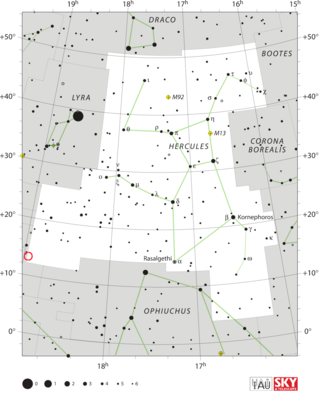Top Qs
Timeline
Chat
Perspective
V446 Herculis
1960 Nova event in the constellation Hercules From Wikipedia, the free encyclopedia
Remove ads
V446 Herculis was a nova in the constellation Hercules in 1960. It reached magnitude 2.8. The nova was first observed by Olaf Hassel in the early morning hours of 7 March 1960, when it was a 5th magnitude star. Pre-discovery photographs showed that it was about three days past peak brightness, and had faded by 2 magnitudes during that time. The star was so near the border between the constellations of Hercules and Aquila that accurate measurements of its position were needed to determine which constellation contained it.[4]

V446 Herculis was the first nova to have the degree of linear polarization of its light measured. It was determined that the polarization did not arise from the star itself.[5][6]
Like all novae, V446 Herculis is a close binary star system with a "donor" star transferring matter to its white dwarf companion. In the case of V446 Herculis the donor star is a red dwarf[3] and the pair's orbital period is 4.97 hours.[7] Unlike many novae, V446 Herculis is not an eclipsing binary, but it does show dwarf nova outbursts every 13 to 30 days.[3]
Remove ads
References
External links
Wikiwand - on
Seamless Wikipedia browsing. On steroids.
Remove ads

